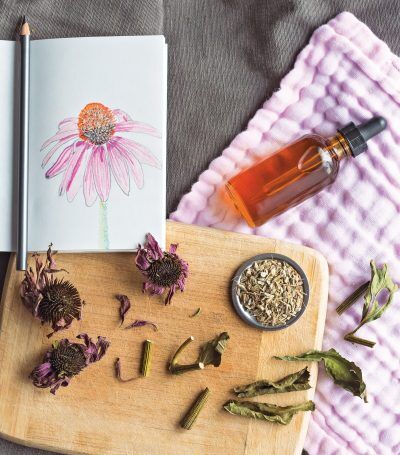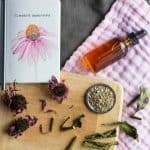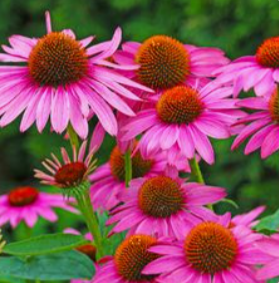The Echinacea plant
The echinacea plant (or Coneflower) is in the Asteraceae family, along with daisies and asters. It’s a perennial prairie flower native to North America, and it was used by Native Americans to help heal wounds or infections.
The most common type of Coneflower is Echinacea purpurea, which has downward pointing petals.
Echinacea flowers range from white to pink or purple. They attract butterflies and birds, and they’re highly tolerant of poor soil, drought, heat, and humidity! These hardy plants are good choices to plant anywhere in zones 3 – 10.
Besides being pretty in a vase or using the ornamental cones in the center of the flower, echinacea is also fantastic for your health.
Growing Coneflower means you have a natural remedy right outside your door!
Related: Dandelion herbal benefits from flower to root
If you enjoy gardening, check out this list of medicinal herbs you need to grow!
Echinacea benefits
I’m sure you’ve heard of echinacea- it has become more and more popular, and that’s because it works! Echinacea helps to boost your immune system and help you get over colds and flu more quickly.
Related: How to make elderberry syrup to give your immune system a boost
The phenols found in echinacea are antioxidants that help protect your body.
Echinacea is also antimicrobial, and some studies suggest that it can help with chronic fatigue, indigestion, migraines, and even UTIs!
Related: The best ways to avoid a UTI naturally
You don’t need to know everything about echinacea to experience its benefits- you can see for yourself how great it is by making your own echinacea tincture!

Reprinted with permission from Healing Herbal Infusions by Colleen Codekas, Page Street Publishing Co. 2018. Photo credit: Colleen Codekas
Echinacea tincture recipe and usage
This recipe is a simple, inexpensive, and effective way to make sure you stay healthy and support your immune system through cold and flu season.
This recipe includes echinacea roots, flowers, and leaves to make it as beneficial as possible. Echinacea root is the easiest plant part to find at stores, however, so if you aren’t able to find the flowers or leaves, just use one cup of the root. Don’t worry- it’ll still be good for you. =)
This recipe is from Healing Herbal Infusions by Colleen Codekas (reprinted with permission). If you like this recipe and want to see tons of other herbal recipes for health, skin care, and more.
Ingredients
- ½ cup (40 g) dried echinacea root
- ½ cup (20 g) dried whole echinacea flowers and/or leaves
- 1½ cups (360 ml) 80 proof vodka
You’ll also need a pint-sized mason jar.
If you’re buying your herbs on Starwest Botanicals (where I get all my bulk herbs) make sure you’re getting the cut herbs and roots, not the powder.
How to make your echinacea tincture
Putting together your echinacea tincture is super easy! Just put the dried ingredients in your mason jar, and shake to combine.
Label the jar with the date, ingredients, type of alcohol you used, and the date your tincture will be ready.
Put the jar in a cool, dark place and give it a shake about every day (or every couple of days- whenever you remember!)
Infuse the tincture for 4 – 6 weeks. It’s fine if you leave it longer- it won’t go bad!
After your mixture has infused, use a fine-mesh sieve to strain the tincture into dropper bottles for easy access. You can compost the leftover plant material!
Printable recipe

Echinacea Root and Flower Tincture
Use this easy-to-make echinacea tincture at the first sign of sickness to help support your immune system for a quick recovery.
Ingredients
- 1/2 cup dried echinacea root
- 1/2 cup dried whole echinacea flowers (or leaves)
- 1 1/2 cups vodka (80 proof)
Instructions
-
Put all dried ingredients in a pint-sized mason jar and cover with alcohol.
-
Cover tightly with a lid and shake to combine.
-
Label jar with ingredients, date, and alcohol used.
-
Let mixture infuse for 4 - 6 weeks, then strain into dropper bottles and label.
This tincture should last you a while, and it’s good for 4-6 years!
Make sure to label your finished tincture with the ingredients, date, and type of alcohol. Once you start making your own natural remedies, it’s easy to forget what’s in a dropper bottle!
Echinacea dosage
For the most benefit, take 5 ml (about 1 teaspoon) of your tincture 2 or 3 times per day.
Take the tincture at the first sign of a cold or flu. You can put the liquid straight into your mouth, under your tongue, followed by a drink of water, or you can mix it into water or tea.
Take your echinacea tincture until your symptoms improve.
If symptoms worsen, or you have a high temperature for multiple days, please go see a doctor!
Echinacea for kids
For kids over two, or anyone who wants to avoid alcohol, you can make this same tincture with a food-grade vegetable glycerin instead of vodka.
There is also a recipe for Elderberry & Echinacea Glycerite for Colds & Flus on page 186 of Healing Herbal Infusions!
Glycerin acts as a preservative but isn’t quite as effective as alcohol, so use your tincture made with glycerin within 1-2 years.
Echinacea side effects
The most common adverse side effects of echinacea occur when companies mislabel and release tainted products, with side effects coming from the additives, not the echinacea itself.
Some products labeled with echinacea don’t even include any of the plant material at all!
In most countries, including the US and UK, herbal remedies are not strictly regulated. If you buy tinctures or herbal concoctions from the store, make sure you trust the companies you buy from.
Making your own tinctures is a great way to avoid getting mislabeled or toxic products. That way, you know exactly what you’re putting in your body!
There are also some rare people with allergies to echinacea. If you have a sensitivity to echinacea, and you start taking your tincture, you might experience a headache or mild nausea. Each time you take echinacea, check for side effects. If you notice a trend, either reduce your dosage or stop taking it and you should be fine!
If you have an autoimmune disease, check with your doctor before adding echinacea, since it has an effect on the immune system.
Echinacea is fine for pregnant and nursing women to use in moderation.
https://www.hopefulholistic.com/echinacea-tincture/
What is Echinacea?
Echinacea purpurea or purple cornflower is a member of the daisy family, which explains its large orange-yellow centers and many surrounding petals. Not only is it a beautiful addition to any homesteader’s garden, it has a myriad of health benefits that I will go into soon.
Echinacea is a prairie loving plant, one that thrives in open areas and even some locations with drought conditions. It is native to North America but is grown worldwide given how easily it takes to many climates and soil conditions.
Packed full of vitamins, minerals, and other health benefits, echinacea is a nutritional powerhouse. Isn’t it nice to have a plant that grows easily, flourishes in many climate conditions, and has a lot to offer the human body? Echinacea ticks all of these boxes!
This plant has been sold in supplement or medicinal form for quite some time, as the entire plant (from flower head to root) can be powdered. But why take echinacea? What might some of the medicinal benefits be?
Health Benefits of Echinacea
Echinacea may seem like a simple daisy or ornamental flower, but this plant is chock full of value, especially if you are interested in homemade and all natural herbal remedies like I am. Here are some of the top health benefits of echinacea.
Immune and Respiratory Health
The top use for echinacea has to be improving your overall immunity and respiratory system health. This delicate flower is used in over the counter treatments primarily for reducing the length of common colds, or even easing many flu symptoms.
I take echinacea at the first sign of a cold, right when I start to get the sniffles. Taking this herbal supplement props up my immune system, and I find that I can stop a cold dead in its tracks, or at the very least temper my cold symptoms!
Antioxidants
While there are countless antioxidants out there, all with complicated names, you can feel good about taking echinacea for its many antioxidant properties. This plant is full of them, the majority of which are found in the flower’s head and petals.
Antioxidants essentially help your cells fight stress or other long-term diseases, and echinacea is full of them. Echinacea also contains compounds that further the life of existing antioxidants, making it a great plant for ongoing antioxidant health. It both provides new, healthy antioxidants to your body and maintains them should you take echinacea supplements regularly.

Calming Effects
Anxiety is something I struggle with every single day. Thankfully, there are many plants that offer anti-anxiety properties, and echinacea is one of them. Many members of the daisy family have this benefit; you’ve heard of chamomile too, I bet. Same family, similar anxiety benefits.
Taking echinacea daily in supplement form can assist with feelings of anxiety, leading to an overall reduction in your nervous energy and thoughts. I love to whip up a cup of chamomile and echinacea tea before bed; I always sleep wonderfully after a cup of these calming herbs!
Inflammation Ease
Many herbs and plants offer anti-inflammatory benefits, and echinacea is one of them. Taking supplements can reduce your body’s overall inflammation and increase your body’s natural ability to heal.
Inflammation is linked to many chronic diseases, from Alzheimers to osteoporosis. Taking echinacea can reduce harmful inflammation, and committing to it for a long period of time could assist with any chronic pain that you may be experiencing.
Skin Health
Yes, echinacea is even good for your overall skin health too! While it isn’t very shelf stable and therefore has trouble making its way into mainstream beauty production, homemade echinacea beauty balms can be a great addition to your morning routine!
Because of its anti-inflammatory properties, this herb can reduce your skin’s overall redness and puffiness, and has many hydrating aspects as well. It is also full of anti-bacterial properties, making it an excellent acne and rash fighter too.
How to Grow Echinacea
Growing echinacea is easy to do no matter your experience level with plants or herbs. I always recommend members of the daisy family as good choices for first-time growers, as most will take to any soil or climate and adapt with ease.
I’ve killed my fair share of plants so that you don’t have to. Here is my how-to guide for growing echinacea flowers!
- Echinacea should be planted from seed or from small starts in spring, once the final frost has occurred and the soil has begun to warm. Planting from seed is easy to do with echinacea as it is an herb that propagates itself easily from its own seeds at the end of the season. However, keep in mind that most young echinacea plants won’t flower their first year; it usually takes them until their second or third year to flower should you grow from seed.
- Ensure that your soil is well-drained, even a little dry, and that your desired echinacea patch is in full sun. I’ve had this plant grow tall enough to shade other parts of itself, and these shaded sections have died off! You can always prune and adjust this plant to your liking so this doesn’t happen; no matter what, keep their patch of dirt sunny and dry!
- Plant your seeds in disturbed and turned over soil; plant your seeds an inch or so deep. Ensure that there are a couple inches separating each seed in case they all take, but most of the time, echinacea will find its own way to sprout, even if the seeds are crowded!
- Water decently as the spring turns into summer, especially if your echinacea is young and trying to grow for the first time. Once you have an established plant, echinacea can be watered a lot less, usually adapting to the natural outdoor climate that it has been planted in. However, if you notice their large flowered heads drooping, take the time to give them a bit of extra water!
- You can grow echinacea in a container if you’d rather, though ensure it is at least three gallons. I find them to be more high-maintenance this way, but they do make festive and cheery container plants! Water the container deeply when the soil dries out, and consider keeping them in partial shade. The most important part? Ensuring that the container has proper drainage!
Using and Consuming Echinacea
Since echinacea is easy to grow and harvest, I highly recommend using and consuming it for many medicinal remedies. But how might you go about this, and what are the best ways to consume this herbal remedy?
I recommend cutting back your echinacea halfway through the summer, when you have a decent amount of blooms. You can cut them down nearly to the soil, leaving a little bit of stalk left should you like to have a second bloom in the late fall.
Take the stalks, flower head and all, and bind them into a bouquet. Hang these flower bundles upside down in a naturally dry place; I usually do this in my kitchen window, which gets a lot of early morning sun.
When the flowers, leaves, and stems have dried out thoroughly, you can grind or food process them into a powder. This powder is perfect for taking as a capsule or pill-form supplement. You can also pluck the petals and leaves from your dried bouquet and steep them in tea.
What are Some Potential Side Effects of Echinacea?
While most herbal remedies haven’t been properly studied for their many health benefits and potential side effects, echinacea remains a fairly safe herb to consume. Here are my recommendations for your echinacea consumption:
- Use echinacea up to three times daily when you are experiencing cold symptoms.
- Always take supplements or tea with food, as echinacea has been known to upset stomachs.
- Echinacea can be safely taken for up to two weeks at a time, but taking this herb consistently over a long period of time has not been properly studied.
- The main side effects of echinacea usually occur if you have natural allergies to the plant; it can agitate existing allergy symptoms as well as asthma.
- If you have any immune system issues or take immunosuppressants, you should not take echinacea, given its ability to alter the immune system.
Conclusion
Echinacea is a wonderful plant to grow in your garden as it is easy to care for, comes in a variety of colors, and has many medicinal benefits. Even beginning homesteaders can feel confident growing this beautiful daisy!
Terms of Use: The information presented on the network is intended to expand personal knowledge and provide general understanding in a variety of fields to help you be active your Creative freedom and nurturing your health. The information presented here does not pretend to be and is not a substitute for medical instructions. Everything presented on the network is the personal opinion of the writers and any decision regarding your action or health choice is your sole responsibility. with regards For complete inner freedom.
Outhematrix (out the matrix) Network management.






